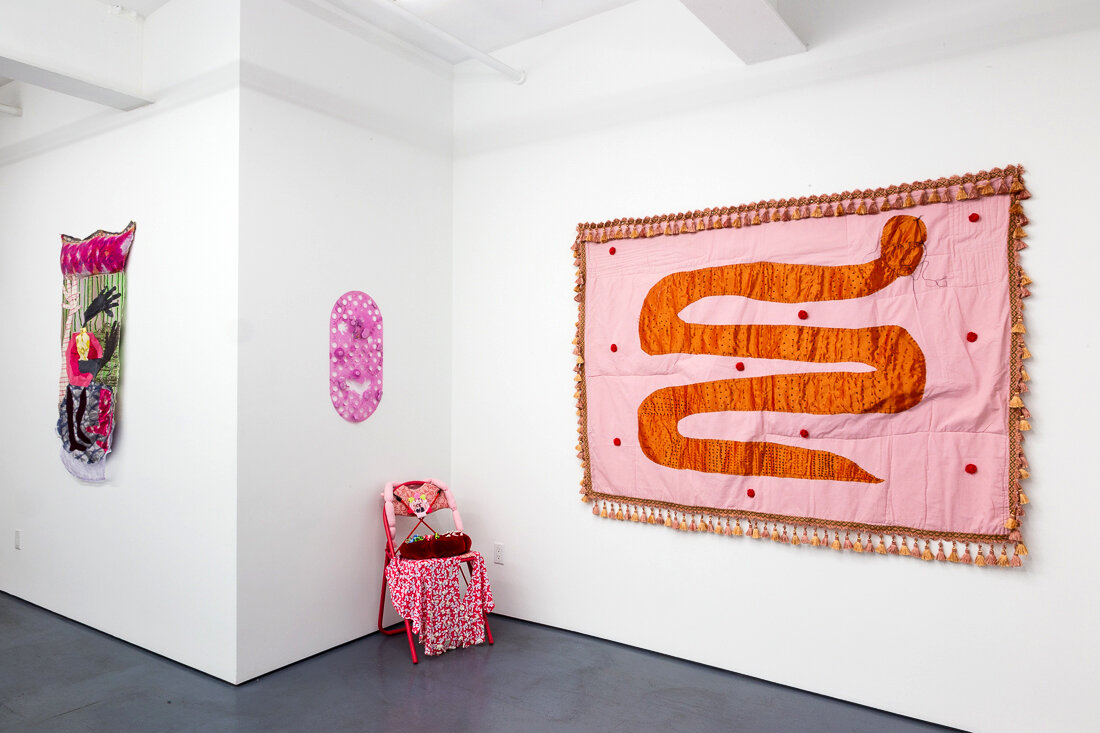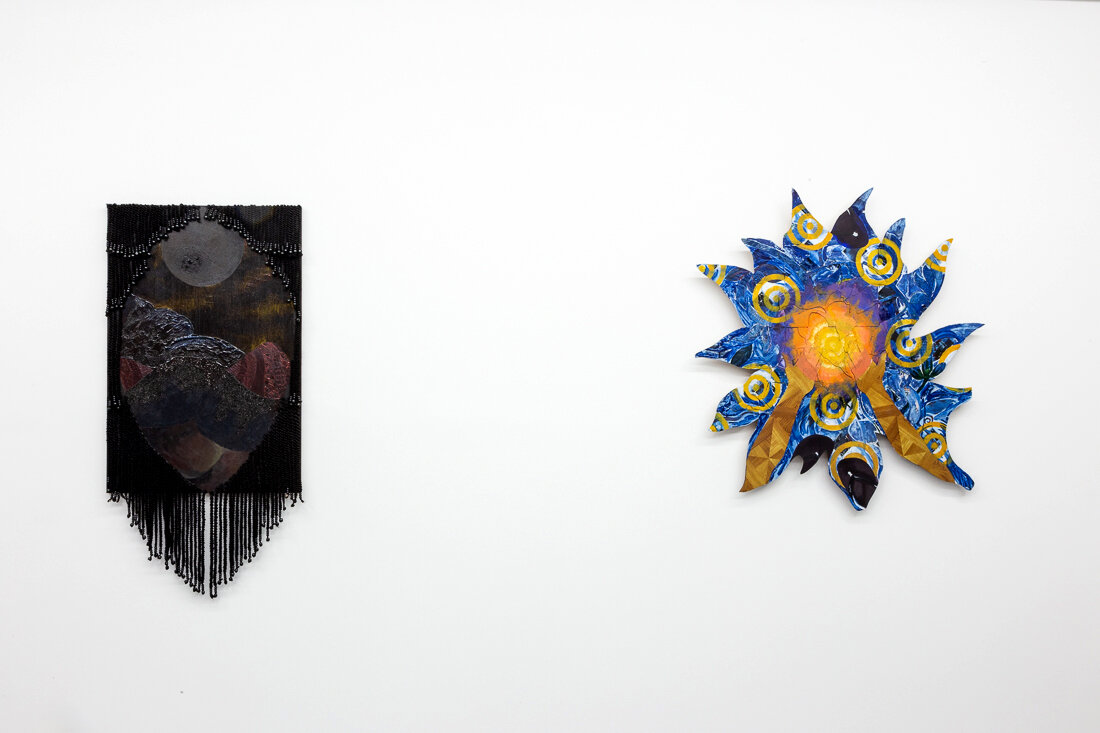Transmitter presents:
Making the Cut
Aruni Dharmakirthi • Leeza Meksin • Dionis Ortiz • Christa Pratt • Padma Rajendran • Ruth Rodriguez • Diane Zhou
February 14 – March 22, 2020
Opening Reception: Friday, February 14, 6–9 PM
ARTIST TALKS
Two artists included in “Making Cut” share insights into their process and materials.
EXHIBITION TOUR
Transmitter is pleased to present Making the Cut, a group exhibition focused on abstracted representations of the human body using textiles and other found materials. The artists included employ items such as cut fabric, vinyl tile, or domestic objects to represent the body in a spectrum of approaches: a self-portrait/astrological birth chart by Christa Pratt, a spa face mask transformed into a seat pillow by Diane Zhou, and a classical representation of the reclining female form reclaimed from the male gaze by Ruth Rodriguez.
The act of layering operates as both a means and a metaphor in the work. The seven artists each create their own unique and complex tapestry of symbols, historical references, and hidden narratives. For insight into each artist’s intentions and process, we asked the artists included in Making the Cut to describe how their choice, and use, of the material, relates to the physical body and the content of their work.
Aruni Dharmakirthi “Textiles have a relationship to the body that begins at birth and ends at death. As an art material, textiles can allude to the body because of the way in which we utilize fabric in our daily lives. I use textiles in my work because of the rich history it has as both a utilitarian object and artistic material. Textile labor is generally seen as women’s work and so I use it to reference the feminine. I am interested in how women have used sewing circles as a way to convene and tell stories. In my work, I create loose narratives through my use of the figure and chaotic sewing style.”
Leeza Meksin “In addition to using a large array of fabrics, from linen and canvas to neoprene, spandex, tulle, and silk, I also use fabrics that have personal meaning to me. Items that were given to me or leftover after the passing of a person I loved. The stiffened fabrics are then formed into an architectural element such as doors and windows. In this case, a large front door, the dimensions taken from the door to my Chinati studio, refer to the ancient Egyptian use of false doors in tombs and temples which allowed the spirit to pass from our world to the next.”
Dionis Ortiz “Working with vinyl tiles is an opportunity to express something expansive and meditative in design. Replacing tiles in my parents’ apartment was an activity my father and I shared to help create a sense of opulence. We would lay new tiles on top of the current tiles and after months of accumulation, we would peel off all the tiles to lay new ones. The reveal of the tiles juxtaposed with the texture of the tile adhesives and burns is a visual reference for me when I am adding texture to patterns. The process of inlaying new tiles requires the use of a blow torch to help release a tile from another tile and minimize the strains on the hands and fingers. I employ a laborious and tedious process of layering vinyl tiles to create a fictitious environment.”
Christa Pratt “I use materials and processes that relate to black femme adornment and visual culture, such as kanekelon braid hair and acrylic nails. The use of these materials acknowledges them as items of black culture, while also allowing the black femme body to enter the work in more abstracted ways.”
Padma Rajendran “Textiles are essential to our lives. They protect our bodies, demarcate identity and social hierarchy, create spaces of rest, and provide emblematic comfort. It is a material we can all read regardless of ‘art’ understanding. The selected works reconstitute textile’s folk art imagery and retell universal events forgotten or unseen. These works indicate how pattern, shape, and painting can come together to inform these universal wishes.”
Ruth Rodriguez “Colorful fabric pattern and solid blocks of color replace skin in my paintings to allude to a sense of torn or mixed identity and the fear that my ethnicity or color will be used as a commodity. My collage materials are taken from my childhood home, consumed goods, one fabric store, and patterns I create on my iPad. Women and floral patterns subtly suggest those tired of being ornaments and decorations. My work is filled with feminine forms that are attempting to reclaim their independence from the male gaze that has dominated not just art history but modern social media outlets. I play with a woman in control and a woman during exhaustion. These women are the outcome of what happens when society subtly continues to feed the role of chef, housekeeper, laborer, manager, mother. In the struggle to get equality we are left exhausted.”
Diane Zhou “In ‘Soppy,’ the bath mat is a manufactured synthetic object that has sustained and repeated contact with the bottoms of the feet, imprinting feet with its patterns and absorbing the moisture and dirt that we carry around, in a mutual exchange. The plasticky smoothness eventually gets corrupted over time as it gets wet and stays in the moist chamber of a bathroom, approaching its eventual disposal. It becomes fallible and deteriorated over time as a living body would. In ‘Rejuvenating Face Mask,’ the shape of the pillow echoes that of a skincare sheet mask but is thickened like a cushy callus, departing from being a second skin on one's face, becoming an entity of its own. The kitschy luxury of the red fabric and the handmade imperfection of the pink rounded tongue shape reflect my process of trying to understand the social currents around the infamous leaked photograph depicting communist party members at an orgy embedded in the work.”

















